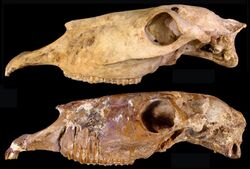Biology:Haringtonhippus
| Haringtonhippus | |
|---|---|

| |
| Scientific classification | |
| Domain: | Eukaryota |
| Kingdom: | Animalia |
| Phylum: | Chordata |
| Class: | Mammalia |
| Order: | Perissodactyla |
| Family: | Equidae |
| Genus: | †Haringtonhippus Heintzman et al., 2017 |
| Species: | †H. francisci
|
| Binomial name | |
| †Haringtonhippus francisci Hay, 1915[1]
| |
| Synonyms | |
| |
Haringtonhippus is an extinct genus of equine from the Pleistocene of North America[2] The genus is monospecific, consisting of the species H. francisci, initially described in 1915 by Oliver Perry Hay as Equus francisci. Members of the genus are often referred to as stilt-legged horses, in reference to their slender distal limb bones, in contrast with those of contemporary "stout legged" caballine true horses.[3]
Haringtonhippus fossils have only been discovered in North America.[3] Specimens have been found from southern Mexico[4] to southern South Dakota and in Alberta, Canada ,[2] at sites such as Gypsum Cave and Natural Trap Cave, as well as eastern Beringia in Yukon[3] A later study found that Equus cedralensis from the Late Pleistocene of Mexico also belonged to this species.[5] The earliest species of the lineage appeared in North America during the Late Pliocene to Early Pleistocene, around 2 to 3 Ma.[3][6] It became extinct at the end of the Late Pleistocene, around 12,000 years ago as part of the end-Pleistocene extinctions, along with most other large mammals in the Americas.[3]
Taxonomy
Haringtonhippus is named after Charles Richard Harington.[3] It was originally described as a new Equus species, E. francisci, in 1915.[1] Dalquest (1979) considered Equus tau Owen, 1869, described from teeth in Mexico, a senior synonym of E. francisci,[7] while Equus quinni and E. arrelanoi were synonymized with E. francisci by Winans (1989).[8] The species Equus achates Hay and Cook, 1930 (synonymized with E. tau by Dalquest 1979) was synonymized with E. francisci by Hulbert (1995), who also declared E. tau and E. littoralis nomina dubia.[2][9]
A 2017 paper placed Equus francisci outside of the crown group containing all living member of the genus Equus based on a phylogenetic analysis of DNA sequences, leading to erection of the new genus Haringtonhippus. The genus is phylogenetically closer to Equus than to Hippidion. It is estimated to have diverged from modern Equus around 4.1–5.7 million years ago, during the late Hemphillian or early Blancan.[3]
| Equini |
| ||||||||||||||||||||||||||||||
Some other authors have argued that the species should be retained in the genus Equus, due to its morphological similarity to members of that genus.[10]
Description
H. francisci was relatively small-sized, with two studies giving estimated body mass ranges of 167 to 251 kilograms (368 to 553 lb)[4] and 175.5–278.4 kilograms (387–614 lb).[11] The third metatarsal (metapodial) bones are slender[11] and similar to those of asses.[3]
Ecology
H. francisci is thought to have had a predominantly grazing based diet, similar to living equines.[4] Dental mesowear analysis of specimens from Natural Trap Cave in Wyoming suggest that the species regularly consumed abrasive vegetation.[12]
References
- ↑ 1.0 1.1 Hay, Oliver P. (1915). "Contributions to the Knowledge of the Mammals of the Pleistocene of North America". Proceedings of the United States National Museum 48 (2086): 535–549. doi:10.5479/si.00963801.48-2086.515. https://www.biodiversitylibrary.org/page/7763692.
- ↑ 2.0 2.1 2.2 †Equus francisci Hay 1915 (horse) at fossilworks.org (retrieved 29 November 2017)
- ↑ 3.0 3.1 3.2 3.3 3.4 3.5 3.6 3.7 Heintzman, P.D.; Zazula, G.D.; MacPhee, R.D.E; Scott, E.; Cahill, J.A.; McHorse, B.K.; Kapp, J.D.; Stiller, M. et al. (2017). "A new genus of horse from Pleistocene North America". eLife 6. doi:10.7554/eLife.29944. PMID 29182148.
- ↑ 4.0 4.1 4.2 Jiménez-Hidalgo, Eduardo; Carbot-Chanona, Gerardo; Guerrero-Arenas, Rosalía; Bravo-Cuevas, Victor Manuel; Holdridge, Genevieve Safi; Israde-Alcántara, Isabel (2019-10-18). "Species Diversity and Paleoecology of Late Pleistocene Horses From Southern Mexico". Frontiers in Ecology and Evolution 7: 394. doi:10.3389/fevo.2019.00394. ISSN 2296-701X.
- ↑ Jiménez-Hidalgo, E.; Díaz-Sibaja, R. (2020). "Was Equus cedralensis a Non-Stilt Legged Horse? Taxonomical Implications For the Mexican Pleistocene Horses". Ameghiniana 57 (3): 284. doi:10.5710/amgh.06.01.2020.3262. ISSN 0002-7014.
- ↑ Weinstock, Jaco; Willerslev, Eske; Sher, Andrei; Tong, Wenfei; Ho, Simon Y.W; Rubenstein, Dan; Storer, John et al. (2005). "Evolution, Systematics, and Phylogeography of Pleistocene Horses in the New World: A Molecular Perspective". PLOS Biology 3 (8): e241. doi:10.1371/journal.pbio.0030241. PMID 15974804.
- ↑ Dalquest, Walter W. (1979). "The Little Horses (Genus Equus) of the Pleistocene of North America". The American Midland Naturalist 101 (1): 241–244. doi:10.2307/2424920.
- ↑ Winans, M. C. 1989. A quantitative study of the North American fossil species of the genus Equus. Pp. 262-297, in The evolution of perissodactyls (D. R. Prothero & R. M. Schoch, eds.), Oxford Monographs Geol. Geophysics, no. 15, 537 pp.
- ↑ Hulbert, R. C. 1995. Equus from Leisey Shell Pit 1A and other Irvingtonian localities from Florida. Bulletin of the Florida Museum of Natural History 37:553—602.
- ↑ Barrón-Ortiz, Christina I.; Avilla2, Leonardo S.; Jass, Christopher N.; Bravo-Cuevas, Víctor M.; Machado, Helena; Mothé, Dimila (12 September 2019). "What Is Equus? Reconciling Taxonomy and Phylogenetic Analyses". Frontiers in Ecology and Evolution 7. doi:10.3389/fevo.2019.00343.
- ↑ 11.0 11.1 Landry, Zoe; Roloson, Mathew J.; Fraser, Danielle (December 2022). "Investigating the reliability of metapodials as taxonomic Indicators for Beringian horses" (in en). Journal of Mammalian Evolution 29 (4): 863–875. doi:10.1007/s10914-022-09626-4. ISSN 1064-7554. PMID 36438779. PMC 9684255. https://link.springer.com/10.1007/s10914-022-09626-4.
- ↑ Spencer, Lillian M.; Scott, Eric (February 2023). "Resource partitioning among late Pleistocene herbivores of Natural Trap Cave, Wyoming" (in en). Quaternary International 647-648: 88–93. doi:10.1016/j.quaint.2022.05.019. https://linkinghub.elsevier.com/retrieve/pii/S1040618222001926.
Wikidata ☰ Q692464 entry
 |

